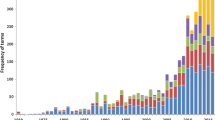Abstract
Google Scholar Metrics has been considered an alternative source for analyzing the impact of academic publications. Its free access, user-friendly interface, and wide coverage have contributed to its growing popularity. However, it presents several challenges, such as the absence of advanced search engines and data extraction tools, the lack of bibliometric standardization, and the non-identification of self-citations, making it difficult to use in large-scale research. To address these challenges, Gsm_hdata was developed as a bibliometric tool for research, extraction, and analysis of citation data from the h5-index of Google Scholar Metrics. The tool consists of four resources that perform automatic searches and data extraction of indexed publications, identify and calculate journal self-citation indicators, and allow for yearly data updates. Initial tests have shown that the tool is efficient and accurate. However, some manual cleaning and verification steps are still necessary. There is room for improvement in the tool, including the implementation of a certification system for the publication search engine to avoid errors with homonymous or similarly titled publications. With technical improvements and more robust tests, Gsm_hdata has the potential to become a relevant tool for bibliometric studies. As well as being used in empirical research, this innovative tool can be used by funding agencies that choose the h5-index as a journal impact indicator.









Similar content being viewed by others
Data Availability
Data sharing not applicable to this article as no datasets were generated or analyzed during the current study.
References
Delgado-López-Cózar E, Cabezas-Clavijo Á (2013) Ranking journals: could Google Scholar Metrics be an alternative to. J Cit Rep Scimago J Rank? Learned Publishing 26(2):101–113. https://doi.org/10.1087/20130206
Waltman L (2016) A review of the literature on citation impact indicators. J Informetrics 10(2):365–391. https://doi.org/10.1016/j.joi.2016.02.007
Delgado López-Cózar E, Orduña-Malea E, Martín-Martín A (2019) Google Scholar as a Data Source for Research Assessment. In W. Glänzel, H. F. Moed, U. Schmoch, & M. Thelwall (Eds.), Springer Handbook of Science and Technology Indicators (pp. 95–127). Springer International Publishing. https://doi.org/10.1007/978-3-030-02511-3_4
Martín-Martín A, Ayllón J, Orduña-Malea E (2014) Google Scholar Metrics 2014: a low cost bibliometric tool. EC3 Working Paper 17. https://doi.org/10.48550/arXiv.1407.2827. ArXiv.Org
Hirsch JE (2005) An index to quantify an individual’s scientific research output. Proceedings of the National Academy of Sciences, 102(46), 16569–16572. https://doi.org/10.1073/pnas.0507655102
Jacsó P (2012) Google Scholar Metrics for Publications: the software and content features of a new open access bibliometric service. Online Inf Rev 36(4):604–619. https://doi.org/10.1108/14684521211254121
Kousha K, Thelwall M (2008) Sources of Google Scholar citations outside the Science Citation Index: a comparison between four science disciplines. Scientometrics 74(2):273–294. https://doi.org/10.1007/s11192-008-0217-x
Delgado-López-Cózar E, Cabezas-Clavijo Á (2012) Google Scholar Metrics: an unreliable tool for assessing scientific journals. El Profesional de La Informacion 21(4):419–427. https://doi.org/10.3145/epi.2012.jul.15
Gusenbauer M (2019) Google Scholar to overshadow them all? Comparing the sizes of 12 academic search engines and bibliographic databases. Scientometrics 118(1):177–214. https://doi.org/10.1007/s11192-018-2958-5
Yu T, Yu G, Song Y, Wang MY (2018) Toward the more effective identification of journals with anomalous self-citation. Malaysian J Libr Inform Sci 23(2):25–46. https://doi.org/10.22452/mjlis.vol23no2.2
Delgado López-Cózar E, Robinson-García N, Torres-Salinas D (2014) The Google scholar experiment: how to index false papers and manipulate bibliometric indicators. J Association Inform Sci Technol 65(3):446–454. https://doi.org/10.1002/asi.23056
Schreiber M (2009) The influence of self-citation corrections and the fractionalised counting of multi-authored manuscripts on the Hirsch index. Annalen Der Physik (Leipzig) 18(9):607–621. https://doi.org/10.1002/andp.200910360
Rousseau R (1999) Temporal differences in self-citation rates of scientific journals. Scientometrics 44(3):521–531. https://doi.org/10.1007/BF02458493
Teves L, Julián J (2020) Cueto. “Social Network Analysis (SNA) Applied to Current Issues. Guidelines for Its Implementation in Research and Management Projects.” AWARI, vol. 1, no. 2, Dec. https://doi.org/10.47909/awari.80
Pinto AL, Canto D, Gavron FL, E. M., Talau M (2020) Periódicos científicos brasileiros indexados no Google Scholar Metrics. Informação & Sociedade: Estudos 30(4):1–18. https://doi.org/10.22478/ufpb.1809-4783.2020v30n4.57048
Do Canto FL, Pinto AL, Gavron EM, Talau M (2022) Latin american and caribbean journals indexed in Google Scholar Metrics. Scientometrics 127(2):763–783. https://doi.org/10.1007/s11192-021-04237-x
Luiz Pinto A, Segundo WLRDC, Dias TMR, Silva VS, Gomes JC, Quoniam L (2022) Brazil developing current Research Information Systems (BrCRIS) as data sources for studies of research. Iberoamerican J Sci Meas Communication 2(1). https://doi.org/10.47909/ijsmc.135
Segundo W, Dias TM, Moreira T, Pinto AL, Silva V, Gomes J, Quoniam L, Matas L, Dias A, Schneider J (2022) A strategy for collection, integration, and processing of scientific data in BrCris context. In T. M. Rodrigues Dias (Ed.), Advanced Notes in Information Science (Vol. 2). ColNes Publishing. https://doi.org/10.47909/anis.978-9916-9760-3-6.117
Acknowledgements
Adilson Luiz Pinto would like to thank the Conselho Nacional de Desenvolvimento Científico e Tecnológico - CNPq. Process 402042/2022-0 and 200937/2022-7. Post-Doctorate Abroad. Protocol 7763808095369450.
Author information
Authors and Affiliations
Corresponding author
Ethics declarations
Conflict of Interest
The authors have no conflict of interest to declare that are relevant to the content of this article.
Additional information
Publisher’s Note
Springer Nature remains neutral with regard to jurisdictional claims in published maps and institutional affiliations.
Rights and permissions
Springer Nature or its licensor (e.g. a society or other partner) holds exclusive rights to this article under a publishing agreement with the author(s) or other rightsholder(s); author self-archiving of the accepted manuscript version of this article is solely governed by the terms of such publishing agreement and applicable law.
About this article
Cite this article
do Canto, F.L., Pinto, A.L., Dias, T.M.R. et al. Gsm_hdata: a bibliometric tool to analyze data from google scholar metrics. Mobile Netw Appl (2023). https://doi.org/10.1007/s11036-023-02258-9
Accepted:
Published:
DOI: https://doi.org/10.1007/s11036-023-02258-9



